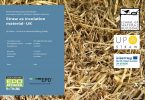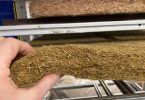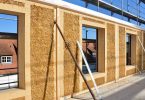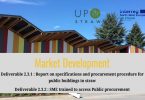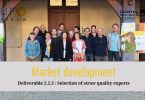Depuis une dizaine d’années, la construction de bâtiments en paille refait son apparition sur le marché européen. Souvent auto-construits, ces bâtiments parfois bâtis seulement à l’aide de paille et de terre suscitent aujourd’hui beaucoup d’intérêt quant à leurs performances énergétiques et leurs qualités environnementales. Suite à la construction d’un bâtiment administratif en paille porteuse par la Municipalité de Lausanne en 2011, un retour d’expérience sur les qualités thermiques du bâtiment a été souhaité par l’ensemble des acteurs du projet. L’objectif de cette étude est donc d’analyser différents aspects des performances thermiques et énergétiques de ce bâtiment. L’étude présente tout d’abord un bilan des différents labels énergétiques proposés sur le marché Suisse et français en 2014, puis propose une classification des types de constructions en paille ; ECO46 est ensuite intégré dans ce contexte.
L’étude se poursuit sur la conductivité et la capacité thermique de la paille à travers des recherches bibliographiques et des analyses d’expériences sur le terrain. A partir de ces résultats, un modèle thermique dynamique est crée sur le logiciel Pléiades+Comfie puis calibré à l’aide de deux séries de mesures en été et en hiver. Le modèle fait ensuite l’objet de nombreuses variations aussi bien au niveau de son design que du comportement des utilisateurs afin d’analyser la sensibilité du bâtiment à ces différents paramètres. Une analyse détaillée de la consommation et production électrique est ensuite présentée pour évaluer les performances du bâtiment au niveau de sa consommation électrique. Enfin une étude du cycle de vie du bâtiment à l’aide du logiciel SimaPro présente l’évolution de la consommation d’énergie d’un bâtiment construit en 1975 jusqu’aux constructions actuelles, puis compare les principaux impacts environnementaux du bâtiment en paille à des solutions standard. Ces résultats ont enfin été regroupés sous la forme d’une plaquette d’aide à la décision pour les entrepreneurs et architectes souhaitant construire un bâtiment en paille.
It is around 10 years that straw buildings have reappeared on the European construction market. Often self-built, these buildings are sometimes made only with straw bales and soil, arousing interest for their energy and sustainability performance. Following the construction of an administrative “straw bale” building by the Municipality of Lausanne in 2011, the local stakeholders required feedback on the energy consumption of this “alternative” building concept. The purpose of this study is to analyze different aspects of the thermal and energy performance of this building. An overview of different building energy labels which exist in the Swiss and the French market (during 2014) was made, and classification of straw bale constructions types is proposed; ECO46 building is presented in this context.
The conductivity and heat capacity of the straw material were investigated through literature review and some field experiments. Subsequently, a dynamic thermal model was created, using the extracted thermal properties, by means of Pleiades+Comfie software. The model was calibrated against two sets of measurements in summer and winter. To assess the sensitivity of the building, the model was subjected to some changes both in the building design and the user behavior. To assess the energy/electricity efficiency of the building, a detailed analysis of the electricity consumption and production was performed. Finally, the life cycle assessment (LCA) of ECO46 using SimaPro software was carried out to show the evolution of energy consumption from a building constructed in 1975 to the current construction and to evaluate the main environmental impacts of straw bale building compared to some standard solutions. These results have been summarized in a decision support booklet for contractors and architects who wish to build a straw bale building.
Author: ADRIEN CHAUSSINAND


